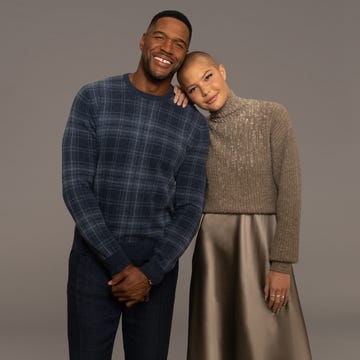In the spring of 2022, the family of actor Bruce Willis announced that the Die Hard star had been diagnosed with aphasia, a disorder that affects how a person communicates—but that wasn’t the full story. The following year it was revealed that Willis’s specific diagnosis was frontotemporal dementia (FTD), making him one of an estimated 60,000 Americans living with the disease, which can impact language skills, behavior patterns, and movement.
While there are no treatments and no cure for FTD, the diagnosis did inspire Emma Heming Willis, 46, Bruce’s model, writer, and entrepreneur wife, to not only share her family’s story but to take up advocacy to fight the disease. She has been open about the challenges FTD has presented her family and has become active in work to push forward legislation and research regarding the disease; next she’s writing a book about her experience, and in 2025, she will receive the Susan Newhouse & Si Newhouse Award of Hope from The Association for Frontotemporal Degeneration (AFTD) for her contributions to FTD awareness.
Here, Willis speaks candidly about her husband’s diagnosis, its impact on her and their young daughters, and the ways in which speaking out for people living with FTD and those who help care for them has become a driving force in her life.
Katie Couric: When you’re a reporter, you’re told not to ask someone who’s going through something difficult, “How are you doing?” But it’s still an important question. So, how are you and your family doing?
Emma Heming Willis: Today I’m much better than I was when we first received the FTD diagnosis. I’m not saying it’s any easier, but I’ve had to get used to what’s happening so that I can be grounded in what is, so that I can support our children. I’m trying to find that balance between the grief and the sadness that I feel, which can just crack open at any given moment, and finding joy.
KC: I relate to what you’re going through. When my husband was diagnosed with stage four colon cancer, my girls were just five and one. I think about your kids and trying to explain what’s happening to their dad. How have you been able to help them understand the situation?
EHW: This disease is misdiagnosed, it’s missed, it’s misunderstood, so finally getting to a diagnosis was key so that I could learn what frontotemporal dementia is and I could educate our children. I’ve never tried to sugarcoat anything for them. They’ve grown up with Bruce declining over the years. I’m not trying to shield them from it.
KC: How old were they when he first started showing symptoms?
EHW: I say that FTD whispers, it doesn’t shout. It’s hard for me to say, “This is where Bruce ended, and this is where his disease started to take over.” He was diagnosed two years ago, but a year prior we had a loose diagnosis of aphasia, which is a symptom of a disease but is not the disease.
KC: When you finally did get the diagnosis and you had a name to put to what Bruce was experiencing, how did you handle it?
EHW: What I learned from our therapist was that if children ask questions, they’re ready to know the answer. If we could see that Bruce was struggling, I would address it with the kids so they could understand, but this disease is chronic, progressive, and terminal. There is no cure. Obviously, I don’t like to speak about the terminal side of this with them, nor have they asked. They know that Daddy’s not going to get better.
There is no treatment, which is why I’m out there raising awareness, so that they can see that we have some agency in this. I’m not going to allow FTD to take our whole family down. Bruce wouldn’t want that. They’re going to see me fight for our family, have some hope, and help the next family out there.
This is not the opportunity that I would want, but it’s the opportunity that’s been presented. I wanted them to see us come out with our family statement, and I get goosebumps thinking about it how it was received with so much love and compassion. We’ve been able to raise awareness on a global scale, and they could see the reach and impact that their father has. That’s a beautiful thing.
KC: You’re also close to Bruce’s adult children. How have you been able to involve the whole family in his care?
EHW: The family respects the way I’m looking after him; they really support me. If I need to vent, if I need to cry, if I need to rage—because all of that can happen and it’s okay to have those feelings—they are always there to listen. I’m so thankful that we are this blended family. They’re very supportive, very loving, and very helpful, and a lot of people don’t have that.
KC: You’ve said that getting an accurate FTD diagnosis is often a long and lonely process. Can you explain what it is and how it differs from other neurodegenerative diseases?
EHW: All neurodegenerative diseases are different. FTD is the most common form of dementia for people under the age of 60. FTD affects the frontal part of the brain and the temporal lobes, so it can affect movement, behavior, and language, and because it’s progressive it can also spread. For Bruce, it started in his temporal lobes and then has spread to the frontal part of his brain. It attacks and destroys a person’s ability to walk, think, make decisions.
KC: Can you describe how the disease has manifested itself?
EHW: For Bruce, it started with language. He had a severe stutter as a child. He went to college, and there was a theater teacher who said, “I’ve got something that’s going to help you.” From that class, Bruce realized that he could memorize a script and be able to say it without stuttering. That’s what propelled him into acting. Bruce has always had a stutter, but he has been good at covering it up. As his language started changing, it [seemed like it] was just a part of a stutter, it was just Bruce. Never in a million years would I think it would be a form of dementia for someone so young.
KC: Why do you think there hasn’t been more research into this disease? This must be maddening for you.
EHW: It’s this underdog of a disease, and I don’t know why. Now I am raising my voice and trying to have legislators hear the definition of what FTD is and realize there is so much work to do. I’m going to do the best I can to raise awareness to get to a treatment or a cure. In New York, State Senator Michelle Hinchey, whose father, Maurice Hinchey, had primary progressive aphasia frontotemporal dementia, has become such an incredible advocate. I’ve been following her lead in a lot of things. I was in New York a couple of months ago to support her for this FTD registry, so that when anyone in the state of New York is diagnosed, it gets recorded. What she’s doing in New York I’m copying and pasting here in California. If she can get the FTD registry done in New York, I’m going to try to bring that here. I didn’t know anything about this type of advocacy, so I’m starting at the ground, going to the state capital and raising my voice.
KC: You’re in a position where you can afford care for Bruce, but a lot of families are not able to do that. And I’m sure you think, How in the world are they getting by?
EHW: This disease takes a team, but some people are doing it solo, and I don’t know how. Because I have this support in place, I’m able to be a mother to my children, continue my work, be the best caregiver I can be to my husband. I also have the energy, because of that support, to be able to go out and raise awareness. I also feel guilty about the access that I have that other people do not. So, as much as it’s important to raise awareness for FTD, my hope is that someone in government will understand that caregivers need support. Paid caregiving is very expensive, and rightly so; caregivers deserve absolutely every single cent that they earn, but the average American can’t afford it.
KC: You have formed a meaningful community on social media by sharing your story. Tell me why you wanted to do that.
EHW: It’s a beautiful thing when you can be in a room with other care partners who have been on this journey and understand it. Being able to connect more with social media, I wanted other people to know that they’re not alone.
KC: It sounds as if it was more than just controlling the narrative. It was about joining and even building a community.
EHW: I’m writing a book for caregivers right now. It’s not just about how to care for your loved one, it’s about how to look after yourself in the process. All these experts and clinicians who have helped me find my own footing in this have said, “You cannot be a caring partner for your loved one if you are not caring for yourself.” This book is about all the emotions that come with caregiving: the sadness, the grief, how traumatic it is, but also resentment and anger, and all these emotions that you’re not allowed to talk about. It’s the book that I wish I had been handed when we got the FTD diagnosis. I wish I had heard from someone, like, “I know this feels horrible and very traumatic, but you’re going to be okay.”
KC: It’s a loss, right?
EHW: We had so many plans, so many beautiful things we wanted to do with our girls, so many things that we wanted to experience together. You just rip that page out completely, and then how do you rewrite the story? I’m learning how to take some control back. It might not be the most beautiful story I could have thought of, but there are cracks of light. There’s been an enormous amount of strength and a lot of beautiful things that have come from this diagnosis, and I’m trying to throw it back into the pot so other people can know that they will be okay over time.
KC: Obviously, this has been a terrible experience, but also I’m hearing you say it has brought about incredible growth. I’m curious how it has changed you.
EHW: I’m a rule follower type, and Bruce is the opposite of that. I’ve learned so much from him about how to be able to use your voice and do good. This is bigger than me, and as Bruce would say, “You gotta get outta your own way, Emma.” That’s what I’m really trying to do—be brave and bold and things that I was not prior to this.
Photographs by Peggy Sirota
Styled by Alison Edmond
Hair by Dennis Gots at Forward Artists. Makeup by Terri Apanasewicz. Manicure by Emi Kudo at A-Frame. Set design by Francisco Vargas. Shot at Studio Stropa
In the top image: Emma Heming Willis’s advocacy around frontotemporal dementia is inspired by her husband Bruce Willis’s experience with the disease. Stella Mccartney jacket ($2,500) and pants ($1,900); David Yurman hoop earrings ($2,750), bangle ($4,950), and rings (from $6,950).
This story appears in the November 2024 issue of Town & Country. SUBSCRIBE NOW
















